|
November 1947 Popular Science
 [Table of Contents] [Table of Contents]
Wax nostalgic about and learn from the history of early
electronics. See articles from
Popular
Science, published 1872-2021. All copyrights hereby acknowledged.
|
My guess is that if
today someone publically bragged about building a personal cyclotron, every
three-letter agency in the country would be all over him like flies on
stink (white on rice, chose your idiom), flack jackets donned, weapons on full
auto, laser sights projected on center of body mass. A similar scenario might
have occurred to these kids at a California high school back in 1947 after this
story appeared in Popular Science magazine, especially since only two
years passed since the world's first atomic bombs had been detonated, and the
purpose of a cyclotron is, among other things, to produce radioactive
substances. Keep in mind as you read through it and look at the pictures that
there were no solid state semiconductors, no personal computers, no CNC machines
or 3D printers, special materials were scarce, and calculations would have been
carried out with paper, pencil, and slide rule. You could not go to the library
and check out a book on how to build a cyclotron, or look it up on the Internet.
At the time the article appeared, this amateur cyclotron had not yet yielded any
radioisotopes, but when/if it did, the budding scientists were prepared to
contain it safely in a leaden foil. That should put your mind at ease. I cannot
write about the subject of nuclear bombs without reminding you of one of my
favorite
Barney Miller TV show episodes.
Boys Build a Cylclotron
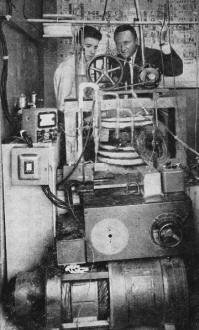
This one-ton, million-electron-volt cyclotron
is five feet high and 2 1/2 feet square. It was built by four boys and their teacher
in three months at a cash outlay of only $500.
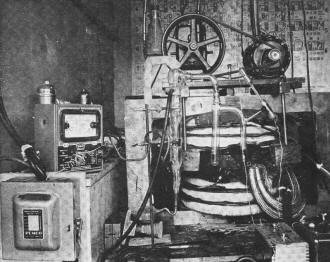
Motor and pump on top are used to start a vacuum
in the accelerating chamber. The pronged glass tubing in front is a mercury diffusion
pump, which completes the job of creating the vacuum. Those things that look like
pancakes are the coils around the poles of the magnet. The acceleration chamber
is located between these two sets of coils.
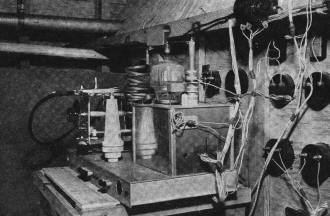
Power transmitter shown here is located in a
room above the cyclotron, and its output is delivered by a variable link coupling
and shielded coaxial cable. Transmitter operates on 2,000 volts at one ampere; and
puts out 1,500 watts of power on a 20-megacycle frequency. The system is designed
to handle a larger, heavy-duty chamber the boys are planning.
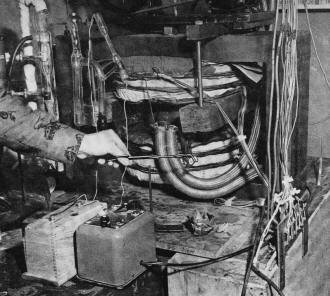
To place a target in the path of the speeding
particles, the operators will use tongs and an opening only 1/2-inch in diameter
near the inlet of the U-shaped coaxial cables.
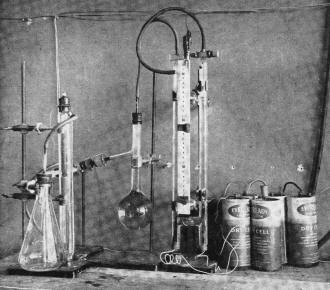
Proton "bullets," nuclei of hydrogen atoms,
are produced in this generator, which breaks water down into its two components.
The hydrogen is passed through an electrically heated palladium valve, at the top
of the tube at the left, and delivered to the cyclotron chamber. There electrons
are knocked off, leaving the proton nuclei to bombard the target.
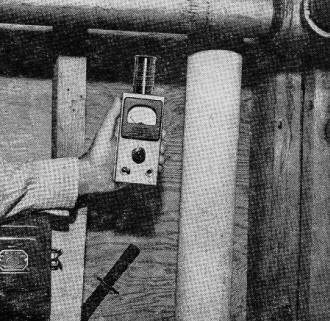
Wave meter shown above is used to detect possible
radio-frequency radiations along pipe lines in the school building. Great care also
is taken to prevent any leakages that might interfere with neighborhood radios and
bring federal authorities down on the operation.
This little atom smasher, designed by California high school students, works
just like the big ones.
By Andrew R. Boone
The young nuclear physicist who won the Nobel prize by developing the cyclotron,
Ernest O. Lawrence, started out with a little glass device that looked like a frying
pan. Since then, cyclotrons have become such mammoth, complex, and expensive machines
that the patent holders are rarely bothered by requests for licenses to build them.
But ingenious and industrious youngsters can still build cyclotrons.
This was proved recently at the EI Cerrito, California, High School, where four
students of instructor Ben Siegel built their own cyclotron, put it in a room scarcely
any larger than a clothes closet, and operated it by remote control from a homemade,
plywood instrument panel.
They neither asked nor received any help from the Atomic Energy Commission. They
found, when they had completed it, that they probably had infringed on patents granted
to Dr. Lawrence and assigned by him to the Research Corporation of New York, but
officials of the latter waived royalty claims. So the students now are planning
to use their machine to produce their own radioactive isotopes for further experiments.
They plan to shield nearby workers with tanks of water three feet thick.
A cyclotron is a machine for speeding up subatomic particles by giving them a
series of relatively weak electrical pushes while they whirl around in ever-widening
circles. This is done by placing the acceleration chamber between the poles of a
magnet and maintaining a high vacuum within the chamber to prevent air from retarding
the tiny particles. When finally allowed to fly out of their circular path, the
particles have so much energy that they can be used as bullets against the atoms
of whatever substance has been chosen as a target.
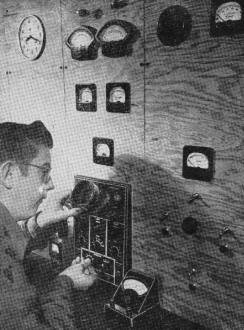
The instrument panel, 3 1/2 by 7 1/2 feet, was
built in sections to make servicing easier. Most of the instruments used were built
by the boys or revamped from Army surplus items.
Building such an atom-smasher, however, is much more of a trick than describing
one. The El Cerrito boys had seen Dr. Lawrence's big cyclotron, and knew what it
did, but they started to build one without any detailed plans for the many intricate
parts that constitute such a machine. "We knew," Siegel told Popular Science Monthly,
"we'd need a magnet, an acceleration chamber, and a high vacuum." Under his direction,
they studied all the literature available, worked day and night, telephoned to friends
for advice when they were stuck, and built their baby cyclotron in a record time
of only three months.
EI Cerrito's shops could not handle the big piece of soft steel chosen for the
magnet, so they went to the Oakland Central Trade School for help. There the chunks
were ground down and welded into a double yoke weighing half a ton. Winding the
coils was the toughest part of the El Cerrito boys' work. For a week, they stood
at a lathe, winding five miles of 13-gauge wire manually, counting each turn aloud
until 6,000 turns had been made. As a result of their painstaking care, the magnet
now will lift a two-ton anvil.
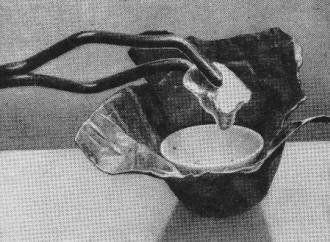
When radioactive isotopes are produced, they
will be removed from the cyclotron and placed in a cup as shown above, to be wrapped
in foil. Gloves will be worn to prevent injury.
To create the necessary vacuum within the acceleration chamber, they use two
pumps. The first, or "roughing," pump is an ordinary mechanical pump driven by a
quarter-horsepower electric motor. The second, which takes over when the first one
has completed its work, is an intricate, mercury diffusion pump, built with the
help of an expert glass blower at the University of California. Many different combinations
of sealers were tried before a way was found to prevent air from leaking in, but
Siegel now believes that the apparatus can produce a vacuum equivalent to only a
very minute fraction of an atmosphere.
The electrical circuits were also troublesome. They had to be redesigned repeatedly
before they functioned properly. Everything in the power system was built over-size
purposely, however, because the students hope to build a larger cyclotron chamber
later for bigger atom-smashing experiments - and the electrical system they now
have will be adequate for their next, bigger cyclotron.
Posted April 29, 2024
|

















